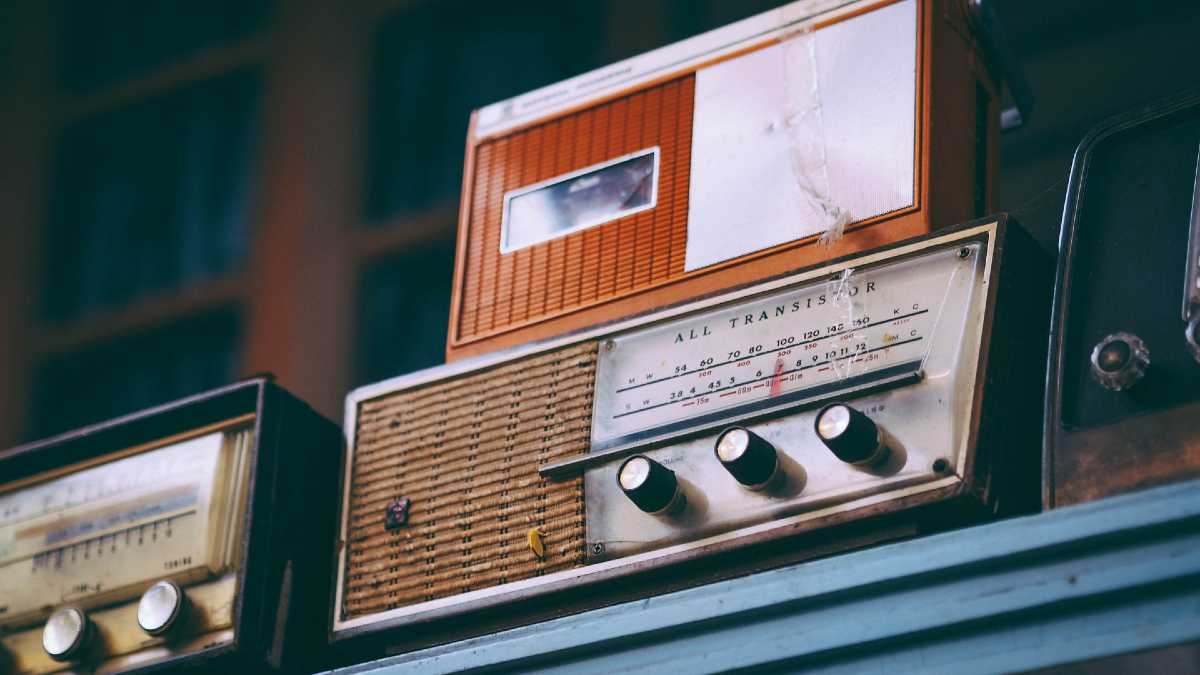 It took 14 years for radio to reach Latin America after the first broadcast in the United States. Today it remains one of the means with a wide penetration.
It took 14 years for radio to reach Latin America after the first broadcast in the United States. Today it remains one of the means with a wide penetration.
Richard Santa
After 100 years of having issued the first signal in Latin America, radio continues to be one of the means of communication with the greatest reach in the region, among other reasons, thanks to the fact that its different signals reach both cities and rural areas, the diversity of devices to listen to it and its offer of information, training and entertainment is extensive.
Argentina was the first country in Latin America to broadcast a radio signal in 1920, in 1921 Mexico joined the list and in 1922 it began in Brazil, Chile and Cuba. And so each year they were added more to the list of countries with active radio signal. In most countries in our region, the technology used to implement radio was provided by Marconi Company.
And although the emergence of television and later the internet made us think that radio would disappear, just as newspapers were thought when radio emerged, time showed that each medium has managed to adapt and evolve, taking advantage of new developments for its benefit.
Today, the evolution of radio technology has allowed the quality of the audio broadcast and perceived by listeners to be much higher, achieving that, according to UNESCO data, radio penetration remains high, higher than 75% in developing countries, such as most of Latin America. Having extensive coverage and free service, it remains one of the most important sources of information and entertainment for the population.
António Guterres, Secretary General of the UN, said on February 13, in the framework of the commemoration of World Radio Day, that "radio retains its special place in each community as an accessible source of news and information. But radio is also a source of innovation: it was a pioneer in giving the audience the floor and broadcasting user-created content several decades before those techniques became widespread."
Recognizing the importance of this half-centenary in our region, we present an account of the number of stations in some of the countries of Latin America:
MEXICO
Mexico City and Monterrey were the first cities in Mexico to have a radio signal in 1921. In the capital of the country the signal could be enjoyed for a few hours on weekends, thanks to equipment installed on the ground floor of the Ideal Theater. The first experiences were experimental with musical programs and also included the presence of declamators.
After 100 years of presence in the country, radio continues to be one of the media with the greatest penetration in the territory and has evolved technologically, since in the region, Mexico is one of the few countries that has begun with the implementation of digital radio.
The Economic Competition Unit of the Federal Institute of Telecommunications, IFT, in the latest diagnostic study of the Sound Broadcasting Service, SRS, in Mexico, yielded interesting data on the growth and importance that continues in this sector, which reaches a coverage of 96% of the territory in AM and 93% in FM.
In the period covered by the study, the authors highlight that the sector in Mexico has experienced very important technological, structural and regulatory changes that have changed market structures, mainly increasing supply, competition and coverage, for the benefit of audiences.
One of the highlights of this period was the realization of the first frequency tender for the commercial SRS in the history of Mexico, which began in 2015 and concluded with the assignment of 114 Stations in FM and 27 in AM. This tender was made after more than 20 years in which no significant frequency assignments were made for the commercial SRS.
In addition, the Institute granted 184 non-commercial concessions that allow the SRS to be provided to public entities and civil organizations and associations, community and indigenous media, as well as private higher education institutions.
The offer grows
The report points out that the IFT's policies allowed the entry of new competitors and the expansion of some established ones, going from 1,516 to 1,841 radio stations, taking care that concentrations contrary to the public interest were not generated.
The commercial radio sector concentrates the largest number with 1,275 stations and a growth of 12.43% in the study period; in public radio there are 326 with a growth of 11.64%; social radio has 170 and a growth of 126.66%; community social radio has 63 and a growth of 425%; and indigenous social radio has 7 increasing 133.33%.
Main players
The study also highlights that the growth of the sector in Mexico has allowed greater competition in commercial radio. At the end of 2018 there were 310 supplier companies, the main ones being:
• Radiorama, with 183 stations and 70.3% of the population covered
• RadioCentro, with 49 stations and 49.2% of the population covered
• GTV, with 17 stations and 48.6% of the population covered
• MVS Group, with 35 stations and 41.8% of the population covered
• Grupo Fórmula, with 39 stations and 51.6% of the population covered
• Acir Group, with 56 stations and 51.1% of the population covered
• Radio Mil, with 9 stations and 28.9% of the population covered
• Multimedia, with 44 stations and 17.3% of the population covered
In Mexico, 82.5% of the commercial SRS stations transmit content in the format of grupera, pop, varied and / or news music, the rest of the stations transmit music of other genres, mainly
COLOMBIA
The first radio broadcast in Colombia was a little later than in the other countries of the region. It was made by the government of the day in September 1929, which would be the beginning of the National Broadcasting Radio. Two years later, the country's first private radio station would be created.
90 years after this first issue, the Communications Regulation Commission, in its latest Industry Report of the ICT and Postal sectors, pointed out that at the end of 2019 there were 1,588 stations registered in Colombia, which received $630 billion Colombian pesos in revenue throughout the year. Of these, 41.8% had a commercial purpose in their activity, while 39.4% was of community vocation and the remaining 18.8% was of public interest.
Commercial broadcasters concentrated most of the revenue, receiving $540 billion Colombian pesos for advertising in 2019. Likewise, it is important to note how this source of income has been exhibiting a decreasing trend during the last years, reducing by 21.7%, in real terms, between 2014 and 2019
Antioquia, Bogotá D.C. and Valle del Cauca concentrated about a third of the commercial stations, while Antioquia, Cundinamarca, Santander and Boyacá grouped 40% of the community stations. In turn, Antioquia, Nariño, Cauca and Boyacá collected just over 30% of the stations of public interest.
Antioquia was the department that registered the highest number of stations in 2019, with a total of 197. Of those, 146 operated in the frequency modulated (FM) band, while 51 operated in the amplitude modulated (AM) band. For its part, Bogotá had 66 stations, of which 34 transmitted on FM and 32 through AM. In contrast, the departments of Guaviare, Guainía, Vaupés, Vichada and Amazonas, presented the lowest number of stations, adding less than 20 among the five.
In Colombia there are several radio groups that concentrate the largest number of stations, with a regional and national presence. Among them are RCN Radio, Caracol Radio, Organización Radial Olímpica, Todelar, Radio Nacional and Canal Caracol, with its two stations, Blu and La Kalle. In addition to a large number of university, community and local radios.
Finally, with regard to audiences and content consumption, it is important to note that, according to the Continuous Radio Audience Study, at the end of 2019 86% of the population in Colombia listened to radio. Of these, 76% preferred music stations, while the remaining 24% looked for spoken ones. In that sense, in the music segment, Olímpica Estéreo consolidated itself as the leading station in large and intermediate cities, while the leadership in the spoken segment remained strongly disputed between Caracol Radio, La W, La FM and Blu Radio.
PERU
Peruvian Broadcasting Company was in charge of making the first radio broadcast in Peru. It was June 1925 and after the success of this station, based in Lima, a year later the government would assume control, starting the National Radio of Peru. After 96 years, radio in this country continues with a penetration of 92% of the population and an interest of the Ministry of Transport and Communications, MTC, to expand the offer by constantly granting licenses.
The Radio and Television Advisory Council, ConcorTV, recently published the report Radio and TV Figures 2020, through which it presented the main indicators of radio and television in Peru: number of stations, number of owners, stations according to purpose (commercial, educational, community), holders of public/state radio and TV, and status of the Codes of Ethics of radio and television owners at the national level.
This report indicates that in Peru there are 5,737 radio stations at the end of 2019, with a growth of 1.2% during the year. Of this total, 5,084 are FM, 586 AM, 48 tropical shortwave and 19 international shortwave. The region with the most stations is Cusco, with 518, followed by Cajamarca with 466, Ancash with 405, Lima with 398 and Puno with 393.
Mostly, the stations in Peru are Commercial, with 4,460, followed by educational with 1,215, and 62 community. Among them are 123 state-owned and/or public-owned broadcasters. According to DGAT figures, at the end of 2020; 80% of districts in the country already have FM radio coverage
The Ministry of Transport and Communications (MTC) has recorded a steady growth in the granting of new authorizations for radio stations during the last five years. There are currently 5,737 stations to provide the sound broadcasting service, achieving an increase of 46%, compared to those in 2014.
At the beginning of 2021, the MTC reported that in 2020 the entity approved 135 new radio authorizations, 21 of them in Puno, being one of the regions most benefited by the new licenses. While, during 2019, 219 new authorizations were granted for sound broadcasting, 29% in areas of preferential social interest, which will benefit more than 22 districts, from nine regions of the country.
The significant growth was mainly registered in the regions of Cusco, Cajamarca, Ancash and Lima, where the authorization of new radios reports the largest increase with 77%, 46%, 33% and 31%, respectively, in the last five years.
Largest radio station concessionaires
The ConcorTV report also highlighted the radio headlines with the highest number of stations nationwide at the end of 2019:
1. Bethel Cultural Association 215
2. Emisoras Peruanas Diversas S.A.C. 114
3. Grupo RPP S.A.C. 104
4. National Institute of Radio and Television of Peru - IRTP 91
5. Radio Panamericana S.A. 59
6. Radio La Karibeña S.A.C. 51
7. Carbajal Luna Julio Cesar 46
8. Radio La Éxito S.A.C. 42
9. Producciones Asturias S.A.C. 37
10. La Luz Ministry 29
Unrated 4,949
ECUADOR
A group of evangelical pastors received authorization to broadcast the first radio signal in Ecuador and form the country's first station, La Voz de los Andes. This broadcast was made from Quito in December 1931. This was the first official radio broadcast, although there are reports of some experimental signals in different regions of the country since 1926.
Today, according to the most recent report of the Agency for Regulation and Control of Telecommunications of Ecuador, Arcotel, with data at the end of 2020, the country has 1171 concessioned sound broadcasting stations, both in AM and FM, divided into Private Commercial, public service and community public service. Of the total number of stations, 1,057 are Frequency Modulated and 114 are amplitude modulated.
By provinces of Ecuador, those that have a greater number of radio stations, both AM and FM, are: Azuay with 104, Guayas with 101, Manabí with 89, Loja with 87, Pichincha with 86, Chimborazo with 73, El Oro with 68, Tungurahua with 62, Santa Elena with 51 and Cañar with 50.
The most important radio groups in Ecuador are: Camorad, Cortel, RCN (Gran Colombia), CRE, SER, AER (Ecuadorian Association of Broadcasting), Deportiva Amistad, Iris and Organización Radiofónica Amistad.
Radio in Ecuador remains a strong medium and the government's interest is to continue strengthening it. To this end, at the beginning of 2020 the Ministry of Telecommunications and Information Society and Arcotel, began a bidding process for 995 frequencies throughout the country, of which 827 were for private media and 168 for community media. In addition, they announced a simplified award process for 308 private media frequencies and 116 for community media. Competitive public processes are also planned for 519 private media frequencies and 52 community media frequencies.
The first stage of this bidding process ended in November 2020 and in January 2021 a second process was initiated in order to deliver the frequencies that were left free.
BRAZIL
The centenary of Brazil's independence in 1922 was the reason for this country's first radio broadcast. That first broadcast was accompanied by the president of the time, Epitácio Pessoa, who also had knowledge in radioelectricity and used them to promote the development of the medium.
This first broadcast took the steps to later create the Radio Society of Rio de Janeiro. Between 1923 and 1924 the sector had a great boost with the emergence of a large number of stations throughout the country.
The most recent report from the Ministry of Communications of Brazil indicates that the country has 24,108 radio stations, of which 22,341 are commercial, 1,267 are educational, 493 of a public nature, 3 public educational and 4 unidentified.
By states of Brazil, those with the most radio stations are: Minas Gerais with 3,676, Sao Paulo with 3,264, Bahia with 2,012, Paraná with 1,754, Rio Grande do Sul with 1,647, Santa Catarina with 1,350, Goías with 1,001, Pernambuco with 961, Pará with 860 and Ceará with 836.
Among the main groups of radio stations in Brazil are: Sistema Globo de Radio, Radio Bandeirantes, Jovem Pan, Central Brasileira de Notícias, Grupo Record, Rádio Clube Paranaense, Super Rádio Tupi.
ARGENTINA
With the opera Parsifal, by Richard Wagner, the first radio signal was broadcast in Argentina on August 27, 1920, thanks to a team brought from France and located on the terrace of the Teatro Coliseo in Buenos Aires. This transmission, carried out by the Argentine Society of Broadcasting, which would later be known as Radio Argentina, reached less than 100 people, but quickly became widespread and opened the way for the development of the industry in the country and the region.
From then to today, according to the Open Data Licensees Table published by the National Communications Agency, Enacom, At the end of 2020 Argentina had 6,126 stations, of which 5,868 are in FM and 258 in AM. It is a significantly higher figure compared to the balance of 2014, when the country had 3,200 stations, which is a reflection of the government's intention to strengthen the offer of this medium.
By media groups, 53% of the stations in Argentina are under three groups: Clarín, Indalo and Prisa, the latter in the process of selling its stations to the Santamartah Group. In addition, there are other groups such as Cadena 3 and Grupo América.
Digital Radio Museum
In 2020 Argentina celebrated the centenary of radio, for which the Ministry of Culture of the country created a Digital Museum, which reviews the history of radio in images, audios and memories from the beginning of this medium with its most memorable programs.
The Digital Museum on Argentine Radio can be consulted on page https://radio.gob.ar/
CHILE
Two engineers professors of the University of Chile were in charge of the first radio broadcast in this country, in August 1922. The signal originated from the electronics laboratory of the University, to a receiver installed in the headquarters of the newspaper El Mercurio. The first station, Radio Chilena, would be founded the following year.
98 years later, Chile has 2,506 stations in current concessions of modulated amplitude, minimum coverage, modulated frequency, community radio and short wave, according to the most recent report of the Undersecretariat of Telecommunications of the Ministry of Transport and Communications.
Of the total number of stations in Chile, 1,909 are fm, 440 are community radio, 147 AM, 9 are minimum coverage and 1 shortwave. By region, La Araucanía has 252 stations, Los Lagos 240, Valparaíso 235, Biobío 231, Coquimbo 205, Maule 201 and the Metropolitan Region of Santiago 194.
By groups of stations, the largest amount is granted to: Megamedia Radio S.A. with 52 stations, Fast Net Comunicaciones S.A. with 51, Radio Corporación S.A. with 46, Bio-Bio Comunicaciones S.A. with 44, Iberoamericana Radio Chile S.A. with 43, Blaya and Vega S.A. with 33, Compañía Chilena de Comunicaciones S.A. with 32, Fundación Armonía with 28, Corporación de Radio Valparaíso LTDA with 25 and Sociedad Radiodifusora Montecarlo LTDA with 25.
Radial Workers' Day
Since 1942, every September 21 is commemorated in Chile the day of the radio worker. This commemoration has a particular beginning. In 1942, the government of that time established that day to turn off the radio for 24 hours so that the workers of the sector could rest, taking into account that throughout the year the stations were operating.
It was only until the year 2000 that the Association of Broadcasters of Chile, Archi, ended this cessation of operations for 24 hours, releasing those who wanted to continue with the activity without risk of sanction. Since then, April 21 has been known as Radio Day and Radio Workers' Day in Chile.

























Leave your comment